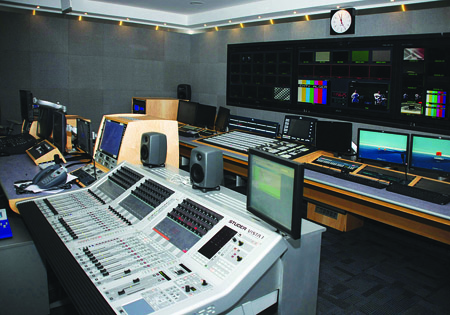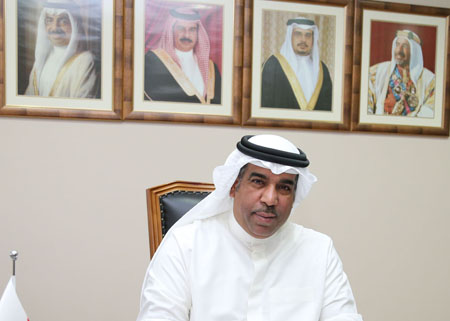Bahrain TV has upgraded its 35-year-old MCR to a new state-of-the-art HD/3G facility, as part of its system revamp. BroadcastPro ME brings you the details Bahrain TV, the TV arm of Bahrains Information Affairs Authority, has been revamping its broadcast infrastructure in phases to build a state-of-the-art facility. It recently refurbished its news studio and upgraded […]
 Bahrain TV has upgraded its 35-year-old MCR to a new state-of-the-art HD/3G facility, as part of its system revamp. BroadcastPro ME brings you the details
Bahrain TV has upgraded its 35-year-old MCR to a new state-of-the-art HD/3G facility, as part of its system revamp. BroadcastPro ME brings you the details
Bahrain TV, the TV arm of Bahrains Information Affairs Authority, has been revamping its broadcast infrastructure in phases to build a state-of-the-art facility. It recently refurbished its news studio and upgraded to an HD setup while also modernising its master control room (MCR).
The MCR project was awarded to Dubai-based systems integrator Glocom Ltd last year and has now been handed over to the broadcaster. The project entailed a complete overhaul of the broadcasters 35-year-old setup to a 24/7 live MCR with full HD infrastructure. The previous setup was a mix of analogue and SD systems.
Alongside revamping the complete MCR, the project also involved installing a monitoring solution for all sources in different levels such as playout, audio processor out, final output, downlink of BTV and other channels. This included multiple remote sites for live feed reception over fibre, two live studios with production control rooms, centralised equipment room, centralised talkback connectivity and continuity rooms for seven-channel master control playout.
Eng. Abdulla Al Balooshi, General Director of Technical and Technology Affairs at Bahrain TV – IAA, explains that in a bid to modernise its broadcast infrastructure, Bahrain TV refurbished its newsroom with key deployments from
Avid and the MCR to create a 24/7 3G environment with main installations from Grass Valley.
With this revamp, we have embraced the latest, state-of-the-art broadcast technology in our facility. We have moved to a full HD environment now, using the latest digital equipment. The core of our MCR was built on Grass Valley, so we decided to go with the latest version from the same vendor. We worked closely with Glocom and Grass Valley to revamp the systems, he says.
Project Manager Ishtiaq Ahmed of IAA, adds: This was the most challenging project for me and I am very happy with the final outcome of the project.
The solution
The facility now boasts a full HD setup with 3G compatible cabling, for more secure connectivity in terms of signal quality and strength. All remote sites used for content acquisition now use fibre connectivity, for faster and safer communication. The solution has several integrated receiver decoders (IRDs) that receive DVB-S/S2 signals and provide SDI-embedded sources for the facility. These sources are taken to the production and transmission routers and used as per requirements.
The central site has a main equipment room with its core based on Grass Valley central production and transmission routers. The MCR receives live feeds from multiple locations, which are fed into both the production and transmission routers. The feeds come to the central location from more than seven remote locations through fibre connectivity via Grass Valley transmitters/receivers, with fibre-to-SDI converters for live record and playout.
The production and transmission routers have the entire sources connected to them for proper routing purposes for all of the studios and continuity rooms. The continuity rooms have seven master control switchers from Grass Valley (4xiMC-Panel-200, 3xiMC-Panel-100) and Grass Valley Densite LGK-3901 for TV channel playout switching and logo insertions. These also include embedded graphics with the logo and ticker feature.
The master control switcher is connected with feeds from various Omneon video servers for video playout. The system uses Vertigo graphics solution for channel branding; sophisticated, multilayer graphics combine text crawls, animated graphics, DVEs and audio inserts.
The monitoring room provides monitoring of all of the 50 SD/HD channel from AXON, with sources from an RF downlink chain and the live feeds coming over fibre. The Trilogy Gemini Talkback system, integrated with the existing Orator system, connects the entire facilitys technical locations for a centralised communication solution.
Al Balooshi says that they have ensured that all of the components are tightly integrated with each other and there is no incompatibility anywhere in the broadcast chain. The data is seamlessly shared between various systems to avoid any delays or downtime.
He adds that the solutions will eventually help to reduce the overall manpower cost without compromising the channels look and feel.
Having most of the systems automated not only reduces our manpower costs, but also reduces the risk of human errors. Each solution has been handpicked with Glocoms design team to serve the purpose, thereby, saving cost and time.
Fibre connectivity between remote sites and central sites give faster access to MCR users. The newly installed systems boast user-friendly GUI of routers, multiviewers and controls to monitor the equipment. The system provides redundancy at all levels, including routers, switchers, sync pulse generators, graphics, glue, multiviewers, and audio and video processors.
Asim Saeed, General Manager of Glocom, explains that the project had its own set of challenges, both expected and unforeseen.
We didnt expect it to be smooth sailing, considering the legacy setup was more than 35 years old and the switch from the existing facility to the new one was bound to be a challenging one. In addition, as the channels were on air, there was no margin for error and we had to restore channel services after making the switch, with zero downtime.
Switching from the old to the new synchronisation from Tektronics SPG8000/ECO8000 SPG (sync pulse generator) for all sources was challenging, primarily because multiple sets of SPGs for different technical sections needed to be connected to each other. Each of these also followed centralised sync for equipment.
Ali Baig, Senior Manager Solution Sales and Operations, Glocom, explains that cabling was another challenge, as we had to segregate all of the old cables and then put new cables in the same places to install the new equipment, without disturbing the legacy setup which was live and in operation at the time of installation.
Glocom was involved in the project at a very early stage and helped the end user with the upfront planning and designing.
We have been using analogue setups all this while, and the switch to digital was a major change for our staff, as they were used to the manual setup. Glocom and Grass Valley invested heavily in undertaking the training of our staff quite effectively in order to equip them to handle the new systems. This was hugely valuable to us in addition to the high quality delivery and implementation, Al Balooshi concludes.














































































